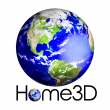Cameras for 3DVista20609
Pages:
1
 WGAN WGANStandard Member Los Angeles |
Home3D private msg quote post Address this user | |
| As Dan knows, I’m bad at checking my DMs here. A member wrote to a month ago but I just read it tonight: “For the virtual tour aspect of 3D Vista, would you recommend the Z1 or the Insta360 1 inch? I understand there is more processing required for the Z1. Any alternative recommendations?” I’m writing from my phone tonight as here in LA we have no power, but so far I’m not downwind from any of the terrible fires raging. Cell phone still works. On 3DVista projects I use three setups. Theta Z1 is still a workhorse. I shoot with it in JPG+raw using its very good HDR mode. Its HDR is amazing in very low light due to the large 1” sensor. It also has a unique mode “Handheld HDR” which does amazing shots on the end of an extended selfie stick. Look at WalkOfFame.us Most of the time I use the raw dual-fisheye DNG shots, process through Lightroom, Theta Stitcher, then cleanup in Affinity Photo. Actually pretty fast workflow once you learn it. I also use the Insta360 1-inch for its ability to capture 9 brackets, then process in Insta Studio and save as DNG. This gives me the benefit of bracketing and a resulting DNG raw format image I can further dynamic stretch in Lightroom. This gave me the best possible shots inside the HillsideTour.com Mausoleum which is quite dark but with blazing bright stained glass windows. Both Z1 and Insta 1-inch yield panos about 7k. The 1-inch tested best for tripod mounted 360 video shots which I used for positions in the Hillside tour capturing the action and sound of waterfalls and fountains. Also did this in the water park outside the Aquaplex in HamptonTour.com For higher resolution I use the Sony A7iv full frame camera with Samyang 12mm fisheye on the Nodal Ninja rig, with or without bracketing as the case may require. I always shoot raw. This yields 9 images (or bracketed multiples of 27 or 45) which are stitched in PTGui Pro to a 16k pano. If bracketing is used, I blend using SNS-HDR app. Examples include Hillside’s Chapel, Hampton’s dusk shots (blue dots) and the Giant Forest area in SequioaTour.com Truthfully, when shooting raw and aiming for the best quality, the processing of each of these is about the same work. Sony full frame on Nodal Ninja absolutely is best quality (slower to shoot) but may be overkill for some situations. Hillside and Hampton are both mostly Z1 with a few HiRes Nodal Ninjas. If image quality is your top priority, learn Nodal Ninja. It’s worth it. Stunning shots. I prefer the Z1 for stills, 1-inch for 360 video nodes. Good luck. |
||
| Post 1 • IP flag post | ||
|
|
ron0987 private msg quote post Address this user | |
| @Home3D Do you get good nadir and zenith coverage using a Samyang 12mm with the Nodal Ninja, do you use Nodal Ninja ring mount or a NN3 style mount. I hope you and your family stay safe good luck with the power. | ||
| Post 2 • IP flag post | ||

|
MeshImages private msg quote post Address this user | |
| Good Luck @Home3D, I hope they will soon get these dramatic fires under control! I was hoping for Ricoh Theta Z2 at CES25, but no news yet. The Insta360 X4 also seems to be a very versatile Camera for Photo and Video and probably also for 3D Gaussian Splats from 360 video input. |
||
| Post 3 • IP flag post | ||
|
|
ron0987 private msg quote post Address this user | |
| @MeshImages Z2 we can only hope, I figured that Theta X has been out for a while that something was on the horizon. | ||
| Post 4 • IP flag post | ||
 WGAN WGANStandard Member Los Angeles |
Home3D private msg quote post Address this user | |
| @ron0987 My Nodal Ninja is the manual 2-axis model. It’s the NN6 version SKU: F6002. It’s been great. Zenith and nadir are completely covered. Six shots around, one straight up. Two straight down. The down shots are 180 from each other to fill in the rig itself. There’s still tripod to retouch of course. I also dream of a Z2. Maybe someday. But Nodal Ninja will still be way better than any one- shot with only two lenses. I haven’t used an X4 yet. I hear it slightly beats the 1-inch in resolution sharpness detail. But I’m told the 1/inch still excels in low light, which makes sense. |
||
| Post 5 • IP flag post | ||
|
|
ron0987 private msg quote post Address this user | |
| @Home3D one last crucial question how are you calculating bracketing breakdown at 9 shot per position. Have you tried the HDR stacking in PTGui Pro? I looked at the software you suggested and I’m going to test it thank you for the info it’s been very helpful as always. |
||
| Post 6 • IP flag post | ||
 WGAN Forum WGAN ForumFounder & WGAN-TV Podcast Host Atlanta, Georgia |
DanSmigrod private msg quote post Address this user | |
Quote:Originally Posted by @Home3D @Home3D Thinking good thoughts for you, family, friends the the entire greater Los Angeles area impacted by the raging fires. Dan |
||
| Post 7 • IP flag post | ||
 WGAN WGANStandard Member Los Angeles |
Home3D private msg quote post Address this user | |
| @ron0987 - Sorry for the delayed reply. Finally dug out computer to write. Winds have calmed for now, fires still burning but have been blown west of us. To your question, using a full-grame camera like Sony mirrorless with 12mm lens (Samyang or Rokinon) on the Nodal Ninja involves 9 shots to create a very clean hi-res pano about 16,000 x 8,000. I've never compared to Matterport or Realsee full res panos using proper focus charts, but to my eye it's superior. Definitely better as you have complete control over the HDR process. I presume MP and Realsee capture 5 brackets as JPG images, then combine. Works quite well. But keep in mind that with a Sony you are shooting raw images with considerable bit-depth. Most of the time I shoot 5 brackets, 2 stops apart, so I've covered 8 stops. When the dynamic range is particularly wide, I'll go to 5 brackets at 3 stops, covering 12 stops. As these are all raw images, the dynamic covering is crazy. Then the HDR process is "auto-assist" but not "auto" like with MP and Realsee. Bottom line, you control it so the results are spectacular. However, this quality does take time, so I use this procedure where I want the best panos possible. On our tours which often have hundreds of panos, I've used this for the key shots / positions and Z1 or Insta for the step positions to get you to the next key shot. I have yet to experiment with gigapixel panos, but intend to. With full-frame camera on Nodal Ninja the sky is the limit. If shooting for hospitality, museum, tourism, where the panos will have a long life, it's exciting to create phenomenally beautiful and detailed shots. If the tour is for retail RE or another temporary use, it doesn't make sense. Just put yourself in the mind of the user. Is it "I just want to see the place" or Notre Dame cathedral: "This is incredible. I'll come back to see this again and again". That's where a gigapixel pano is called for. I have not tried 3DVista's HDR pano process, though it's really intriguing. As I understand, this is a clever solution that emulates the human eye. If you're standing just inside the doorway of an ancient tomb, it would be very bright outside and very dark inside. On a tripod, make several panos appropriate to the different directions one looks, and 3DVista can transition between them according to the direction the visitor is looking. Very clever. I have tried 3DVista's "live pano" process which involves multiple panos but different. Take a pano at noon, sunset and after dusk (making sure they are identical in spatial position) and you can combine them so when a visitor steps to this position the scene fades from day to sunset to dusk, then back to day, at whatever speed you choose. Really magical. |
||
| Post 8 • IP flag post | ||
Pages:
1















